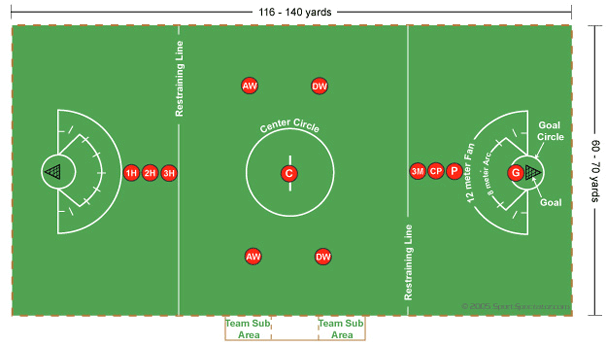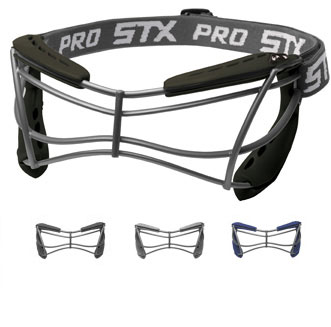New to the game? Click here!The Women's Lacrosse Field:
Rules of the Game: Women's lacrosse is a non-contact game played by 12 players: a goalkeeper, five attackers and six defenders. The object of the game is to shoot the ball into the opponent's goal. The team scoring the most goals wins. Women's lacrosse begins with a draw, which is taken by the center position. The ball is placed between two horizontally held crosses (sticks) at the center of the field. At the sound of the whistle, the ball is flung into the air as the crosses are pulled up and away. A draw is used to start each half and after each goal, and it takes place at the center of the field.
The collegiate game is 60 minutes long, each half being 30 minutes. The high school girl's game is 50 minutes long, each half being 25 minutes. In both collegiate and high school play, teams are allowed two timeouts per game (including overtime).
There are visual guidelines on the side of the field that are in place to provide a consistent indicator to the officials of what is considered the playing field. The minimum dimensions for a field is 120 yards by 70 yards. Additional markings on the field include a restraining line located 30 yards from each goal line, which creates an area where only a maximum of seven offensive players and eight defensive players (including the goalkeeper) are allowed; a 12-meter fan, which officials use to position players after fouls; and an arc in front of each goal, considered the critical scoring area, where defenders must be at least within a stick's-length of their attacker.
The boundaries are determined by the natural restrictions of the field. An area of 120 yards by 70 yards is desirable.
When a whistle blows, all players must stop in place. When a ball is ruled out of play, the player closest to the ball gets possession when play is resumed. Loss of possession may occur if a player deliberately runs or throws the ball out of play.
Rough checks, and contact to the body with the stick or body, are not allowed.
Field players may pass, catch or run with the ball in their stick. A player may gain possession of the ball by dislodging it from an opponent's stick with a check. A check is a controlled tap with a stick on an opponent's stick in an attempt to knock the ball free. The player must be one step in front of her opponent in order to check. No player may reach across an opponent's body to check the handle of a stick when she is even with or behind that opponent. A player may not protect the ball in her stick by cradling so close to her body or face so as to make a legal, safe check impossible for the opponent.
All legal checks must be directed away from a seven-inch sphere or ""bubble"" around the head of the player. No player is allowed to touch the ball with her hands except the goalkeeper when she is within the goal circle. A change of possession may occur if a player gains a distinct advantage by playing the ball off her body.
Fouls are categorized as major or minor, and the penalty for fouls is a “free position.” For major fouls, the offending player is placed four meters behind the player taking the free position. For a minor foul, the offending player is placed four meters off, in the direction from which she approached her opponent before committing the foul, and play is resumed. When a minor foul is committed in the critical scoring area, the player with the ball has an indirect free position, in which case the player must pass first.
A slow whistle occurs when the offense has entered the critical scoring area and the defense has committed a major foul. A flag is thrown but no whistle is sounded so that the offense has an opportunity to score a goal. A whistle is blown when a goal is scored or the scoring opportunity is over. An immediate whistle is blown when a major foul, obstruction or shooting space occurs, which jeopardizes the safety of a player. Posisitions: ATTACK: The Women's Lacrosse Stick: The crosse (lacrosse stick) is made of wood, laminated wood, or synthetic material, with a shaped net pocket at the end. A girl's crosse must be an overall length of 35 1/2 - 43 1/4 inches. The head of the crosse must be seven to nine inches wide. The pocket of the stick must be strung traditionally; no mesh is allowed. The top of the ball when dropped in the pocket must remain even with or above the side walls. The goalkeeper's crosse may be 35 1/2 - 48 inches long. The head of the crosse may be mesh and up to 12 inches wide. All sticks MUST be approved by U.S. Lacrosse.
Goggles: Eyewear is mandatory for the protection of players! All Goggles worn on the lacrosse field must be approved by US Lacrosse.
The Ball: Game balls must be yellow and made of solid rubber.
Mouthguard: All players on the field must wear mouthguards. (Mouth guards may not be white or clear!)
Goalie's Equipment: Goalie must wear a face mask and helmet with a mouth guard (which may not be white or clear!), along with a throat and chest protector. They may wear padding on hands, arms, legs, and shoulders and chest that does not excessively increase the size of those body parts
|
Copyright 2024 - UNLV Women's Lacrosse | Website by LaxTeams.net






